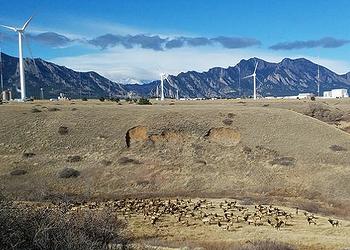
BOULDER, Colorado, June 2, 2017 (ENS) – Citing the threat to human health from radioactive and toxic contaminants at the former Rocky Flats nuclear weapons production facility, five Colorado groups have filed for a preliminary injunction to block federal agencies from building public trails and a visitor center on the site.
The motion filed Wednesday in U.S. District Court in Denver alleges that the site’s current manager, the U.S. Fish and Wildlife Service, FWS, has failed to conduct legally required analyses of environmental risks and policy options.
Secretary of the Interior Ryan Zinke and FWS Acting Director James Kurth are named as defendants in the lawsuit.

If an injunction is not granted, construction is scheduled to begin in June on the site about 15 miles northwest of Denver on a windy plateau.
“If planned construction were to proceed before the proper environmental analyses are complete, plutonium and other hazardous substances on the site could be disturbed. People could be harmed through exposure to these contaminants,” warned LeRoy Moore a consultant with the Rocky Mountain Peace and Justice Center.
Moore said, “We want to make certain that pollutants in the soil at Rocky Flats, including plutonium, beryllium and uranium, do not contaminate members of the public, who FWS unfortunately plans to invite onto the site.”
The lawsuit states, “Rocky Flats is among the nation’s most polluted places. Its name is synonymous with plutonium, a laboratory-developed, radioactive chemical element that was used at the facility to produce nuclear triggers for almost 40 years during the Cold War.”
Plutonium is extremely carcinogenic, with a half-life of around 25,000 years.
During the three decades between the plant’s shutdown and the present, Congress created the Rocky Flats National Wildlife Refuge out of lands surrounding Rocky Flats’ highly contaminated central operable unit, the COU.
The Fish and Wildlife Service now wishes to open the 4,883 acre “refuge” to the public with hiking, biking and equestrian trails, and a major visitors’ center, despite new developments and evolving evidence that the plutonium has migrated beyond the COU.
The FWS has been conducting private tours on the refuge for the last two years and wants to open the “refuge” to the public in the summer of 2018.
But the evidence presented in court includes surveys indicating higher than expected cancer rates among neighbors, unprecedented precipitation events in 2013 and 2015, and information discrediting assumptions made in 2006, when the last comprehensive sampling was done, concerning the inability of the plutonium to migrate beyond the COU.
“What the public does not know can hurt us and our children,” said Bonnie Graham-Reed, co-founder of the plaintiff group Rocky Flats Right to Know. “That’s why a thorough environmental analysis is so important.”
Other plaintiffs include Candelas Glows/Rocky Flats Glows, the Rocky Flats Neighborhood Association and the Environmental Information Network.
The community groups’ attorney Randall Weiner of Boulder said, “An injunction in this case is vital to protect the public interest by preventing additional public health impacts. Federal agencies must complete mandatory environmental analyses before construction can legally begin.”

From the mid-1950s, Rocky Flats manufactured plutonium components for U.S. nuclear weapons. In June 1989, the Federal Bureau of Investigation raided the site for alleged violations of environmental laws. The plant shut down and never reopened.
Jon Lipsky, the former FBI Special Agent who led the raid that shut down Rocky Flats, said in connection with the current lawsuit, “The lack of a thorough environmental analysis allows expert opinions about risks from the site to be swept under the rug.”
Parts of Rocky Flats are on the Superfund list of the nation’s most polluted sites. Radioactive and toxic materials contaminate soils and sediments. Questions about the accuracy of past sampling for plutonium remain unanswered. The plaintiff groups point to recent reports of excess cancers among neighbors.
The lawsuit is based on alleged violations of the National Wildlife Refuge Systems Administration Act, the National Environmental Policy Act, NEPA, and a 1977 Executive Order signed by President Jimmy Carter protecting wetlands.
NEPA, requires public involvement to review decisions that affect the human environment. Federal agencies must explain the impact of their plans and justify all reasonable alternatives to proposed actions.
Weiner explains, “The purpose of NEPA is to require an analysis of environmental effects before the agency’s actions are irreversible. By avoiding the NEPA mandate, the Fish and Wildlife Service is virtually thumbing its nose at its obligations to consider the risks its plans pose to the public. The agency has waited too long to comply with its NEPA responsibilities.”
Meanwhile, governments at all levels have been moving to bring people into the contaminated area, without taking action
action under NEPA, by either preparing an Environmental Assessment, an Environmental Impact Statement or a Supplementary Environmental Impact Statement .
The Rocky Mountain Greenway, a collaboration between federal, state and local governments announced in 2012, is envisioned as a continuous trail or transportation corridor from the Rocky Mountain Arsenal to Rocky Mountain National Park.
In 2016, the FWS revised its trails plans to incorporate the Rocky Mountain Greenway’s trail section through the “refuge,” abandoning the previously planned routes around the perimeter.
To adjudicate these issues, the plaintiff groups are demanding a jury trial.
Copyright Environment News Service (ENS) 2017. All rights reserved.
